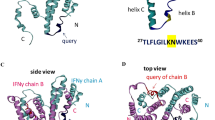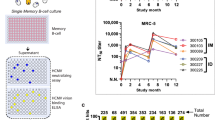Abstract
Human T-cell lymphotropic retrovirus type III (HTLV-III), also called lymphadenopathy-associated virus (LAV), has been identified as the aetiological agent of acquired immune deficiency syndrome (AIDS)1–9.The sera of most patients with AIDS or AIDS-related complexes, and of asymptomatic individuals infected with HTLV-III, contain antibodies against antigens of HTLV-III4,10–12.The characterization of these antibodies and their corresponding viral antigens is important not only for understanding immunity against HTLV-III and the pathology of AIDS, but also for the development of diagnostic methods and preventive vaccine for AIDS. Following the successful establishment of a long-term T-cell line permissive for HTLV-III replication1, large quantities of virus have been produced, facilitating the purification of viral proteins and the development of mouse monoclonal antibodies against several viral antigens10,24.More recently, the structure of HTLV-III proviral DNA has been elucidated13–16.We now report the production, by genetic engineering methods, of a peptide encoded by a gene segment of HTLV-III. A 1.1-kilobase (kb) EcoRI DNA segment from an isolate of HTLV-III was inserted into a lpp and lac promoter-coupled expression vector, pIN-III-ompA. Escherichia coli transformants of this plasmid produced a peptide of relative molecular mass (Mr) 15,000 (15K) which was strongly immunoreactive with anti-HTLV-III antibodies present in sera from AIDS patients. Lysates of the clones expressing this 15K peptide inhibited the reactivity of the p31 virion protein with AIDS sera, suggesting that it is a fragment of the viral p31 protein. The peptide reacted with sera from all 20 AIDS patients but none of the 8 normal controls tested. These results suggest that the peptide may be useful for detecting anti-HTLV-III antibodies in blood samples.
This is a preview of subscription content, access via your institution
Access options
Subscribe to this journal
Receive 51 print issues and online access
$199.00 per year
only $3.90 per issue
Buy this article
- Purchase on Springer Link
- Instant access to full article PDF
Prices may be subject to local taxes which are calculated during checkout
Similar content being viewed by others
References
Popovic, M., Sarngadharan, M. G., Read, E. & Gallo, R. C. Science 224, 497–500 (1984).
Gallo, R. C. et al. Science 224, 500–503 (1984).
Schüpbach, J. et al. Science 224, 503–505 (1984).
Sarngadharan, M. G., Popvic, M., Bruch, L., Schüpbach, J. & Gallo, R. C. Science 224, 506–508 (1984).
Vilmer, E. et al. Lancet i, 753–757 (1984).
Groopman, J. E. et al. New Engl. J. Med. 311, 1419–1422 (1984).
Barre-Sinoussi, F. et al. Science 220, 868–870 (1983).
Broder, S. & Gallo, R. C. New Engl. J. Med. 311, 1292–1297 (1984).
Markham, P. D., Shaw, G. M. & Gallo, R. C. in AIDS (eds Devita, V. T., Helman, S. & Rosenberg, S. A.) (Lippincott, Philadelphia, in the press).
Safai, B. et al. Lancet i, 1438–1440 (1984).
Kitchen, L. W. et al. Nature 312, 367–369 (1984).
Cheingsong-Popov, R. et al. Lancet ii, 477–480 (1984).
Hahn, B. H. et al. Nature 312, 166–169 (1984).
Ayra, S. K. et al. Science 225, 927–929 (1984).
Shaw, G. M. et al. Proc. Natn. Acad. Sci. U.S.A. 81, 4544–4548 (1984).
Ratner, L. et al. Nature 313, 277–284 (1985).
Ghrayeb, J. et al. EMBO J. 3, 2437–2442 (1984).
Rigby, P. W. J., Dieckmann, M., Rhodes, C. & Berg, P. J. molec. Biol. 113, 237–251 (1977).
Chang, N. T. et al. Science 228, 93–96 (1985).
Mölling, K. et al. Nature new Biol. 234, 240–243 (1971).
Levin, J. G., Hu, S. T., Rein, A., Messer, L. I. & Gerwin, B. I. J. Virol. 51, 470–478 (1984).
Laemmli, U. K. Nature 227, 680–685 (1970).
Towbin, H., Staehlin, T. & Gordon, J. Proc. Natn. Acad. Sci. U.S.A. 76, 4350–4354 (1979).
Veronese, F. et al. Proc. Natn. Acad. Sci. U.S.A. (in the press).
Author information
Authors and Affiliations
Rights and permissions
About this article
Cite this article
Chang, N., Huang, J., Ghrayeb, J. et al. An HTLV-III peptide produced by recombinant DNA is immunoreactive with sera from patients with AIDS. Nature 315, 151–154 (1985). https://doi.org/10.1038/315151a0
Received:
Accepted:
Issue Date:
DOI: https://doi.org/10.1038/315151a0
This article is cited by
-
Monoclonal Antibodies that Neutralize HIV–1 Virions and Inhibit Syncytium Formation by Infected Cells
Nature Biotechnology (1987)
-
Detection of Antibodies to Human T-Cell Lymphotropic Virus-III (HTLV-III) with an Immunoassay Employing a Recombinant Escherichia coli-Derived Viral Antigenic Peptide
Bio/Technology (1985)
Comments
By submitting a comment you agree to abide by our Terms and Community Guidelines. If you find something abusive or that does not comply with our terms or guidelines please flag it as inappropriate.



